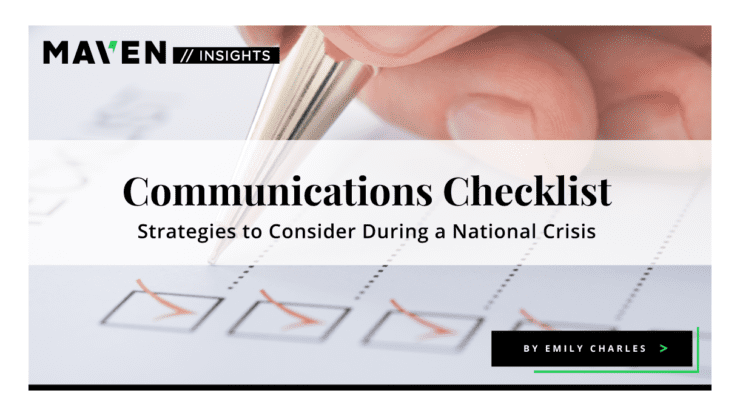The year 2020 was marked by several national crises. Between a global pandemic, raging wildfires, civil unrest and the election, every company was faced with adjusting their communications strategy to reflect the current climate.
The communications checklist below outlines a few initial steps your organization should take the next time the national and international conversation gets swept up by a crisis.
Examine Social Media Content
Many social media managers schedule their organization’s social content in advance. As soon as a crisis dominates the national or local conversation, it’s important to immediately pause and reevaluate your upcoming social media calendar. Read the room! Content posted that doesn’t relate to the issue at hand may seem tone-deaf and upset your audience.
Rethink Media Outreach
With today’s shrinking newsrooms, most reporters are temporarily reassigned to the breaking news desk if there is a national or local emergency. It is best to hold active media outreach until the dust settles. Your email will most likely be ignored anyway and you don’t want your organization to come off as insensitive. Even if the crisis falls on the day of a big announcement – wait it out.
If your spokespersons already have media interviews scheduled in the upcoming days, your media prep should also include potential questions related to the crisis.
Join the Conversation
Next, it’s time to think about internal and external messaging. The decision to participate in the conversation or not depends on a few factors:
» Your organization’s mission and values
» Your organization’s industry, role in the community and economy
» Whether the crisis has a direct impact on your employees, customers or industry
» What you want to communicate and why your voice is important
Identify Audiences & Communication Vehicles
If you plan to address a national crisis, you need to identify your individual audiences and tailor the messaging accordingly. This includes internal communications with employees, partner and client/consumer newsletters as well as social media statements. Since it is most likely a sensitive situation, keep all communications honest, empathetic and authentic to your brand.
Crisis communications can be tricky. Regardless of the specifics, a good rule of thumb is to take a step back, quickly adjust your strategy and keep messaging authentic. Developing and regularly updating crisis communication plans and social media policies can help alleviate most of the guesswork.
Thank you for reading our Insight on communications during a national crisis. For more information on crisis communications, read Rebecca’s Insight “Crisis Communications Post-Data Breach” or Jessica’s article on “Who Your Spokesperson Should Be In a Crisis Situation.”
Posted In Crisis Communications
 Emily White
Emily White 